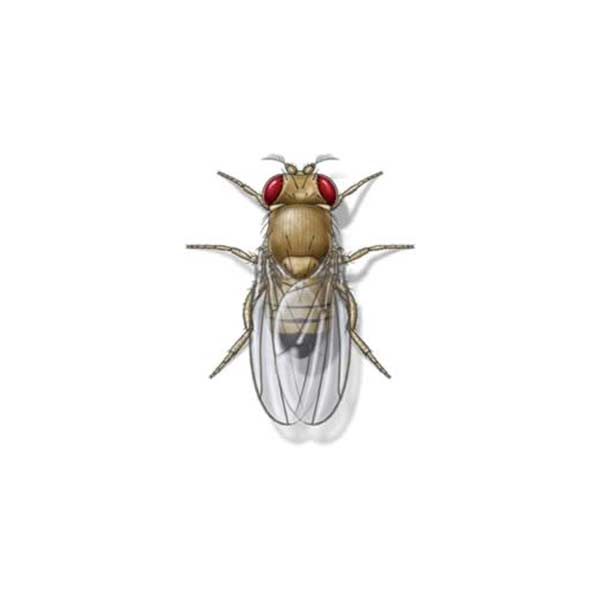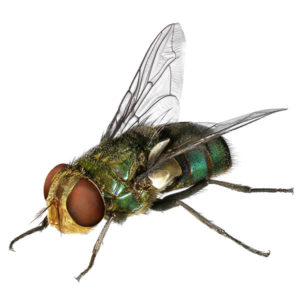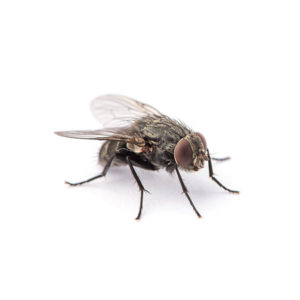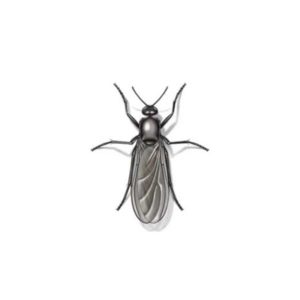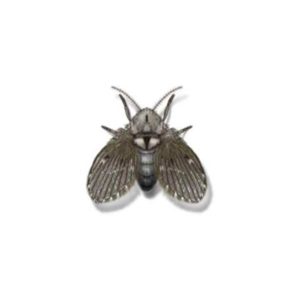Fruit flies are small insects that can quickly become a nuisance in homes, restaurants, and grocery stores, especially in Florida’s warm climate. Over 177 species of fruit flies occur in North America and the north of Mexico, and eight species are believed to be common in the United States. Known scientifically as Drosophila melanogaster, these pests thrive around overripe fruits and decaying organic material. The scientific name, Drosophila, means “lover of dew,” probably suggesting these flies require moist environments to reproduce. While their short lifespan and small size might make them seem harmless, their rapid reproduction and potential to contaminate food can cause significant problems.
Fruit Flies in Florida
What Do Fruit Flies Look Like?
Adult fruit flies are tiny, measuring about 1/8 inch long. They are distinguished by their tan thorax, black abdomen, and bright red eyes (See image above), though some species have darker eye colors. These small flies are often mistaken for fungus gnats due to their similar size. A fruit fly’s wings are transparent, and its body has a slightly rounded shape.
Signs of a Fruit Fly Infestation
A fruit fly infestation usually begins with noticing adult flies hovering around overripe fruits, vegetable scraps, or garbage cans. Fruit flies lay large numbers of eggs on fruit, and the hatched larvae feed on the fruit. You might also spot these pests near compost bins, sink drains, or other moist areas where organic material accumulates. They will often enter structures from nearby dumpsters, trash receptacles, and damp compost piles where fruits and vegetables have been disposed of.
Habitat, Diet, Life Cycle & Behaviors
Where Do Fruit Flies Live?
Fruit flies are small flies that can pass through ordinary insect screens and are often found in homes, restaurants, fruit markets, bars, salad bars, and any other place where fruits and vegetables are found. Warm environments like kitchens or grocery stores provide the perfect conditions for fruit fly populations to grow.
Diet
Fruit flies are attracted to overripe fruits, vegetables, and other fermenting food sources. They feed on organic material, including rotting produce, spilled juices, and even residues left in garbage cans. Fruit flies consume bacteria and sugar from decaying foods and can often be seen near bowls of fruit, glasses of wine, garbage, and trash cans.
Life Cycle
The life cycle of a fruit fly is incredibly short. Fruit flies are active during periods of warm weather; single generations may develop in less than a week when temperatures are between 80° and 89°F. A female fruit fly lays up to 500 eggs on fermenting food sources. Within a few days, the eggs hatch into larvae, which feed on the surrounding organic matter. They then pupate and emerge as adult flies within a week, ready to reproduce.
Behaviors
Fruit flies are highly attracted to fermenting substances and often gather near areas with moisture and decaying organic material. They are known as fruit, vinegar, or pomace flies and are often confused with other small flies found in structures.
Are Fruit Flies Dangerous?
Unlike some insects, fruit flies do not sting or bite. However, they are more than just nuisance pests. A study showed that fruit flies can transfer E.coli, Salmonella, and Listeria to surfaces and relocate E.coli from a contaminated source to fresh, ready-to-eat food. These bacteria can lead to foodborne illnesses if transferred to dishes, flatware, or food preparation areas. While you may not consume the contaminated produce itself, when you eat or drink from these objects, you’re exposed to the same bacteria the fruit fly has transported from site to site.
If you are dealing with a fruit fly problem on your property, contact your local fly exterminators.
How to Get Rid of Fruit Flies?
If you’re dealing with a fruit fly problem, taking immediate action is crucial. Effective removal requires a combination of thorough cleaning, trapping, and, in some cases, professional fly control services.
Start by cleaning your space thoroughly. Remove all overripe fruits and vegetables from counters, wipe down surfaces, and ensure garbage cans are emptied regularly to eliminate food sources. Next, set up fruit fly traps, such as simple vinegar traps, which can effectively lure and catch adult fruit flies. Additionally, potential breeding sites should be disposed of by checking drains, garbage disposals, and compost bins for organic material where fruit fly larvae may develop.
For severe infestations, consider professional residential fly control that can offer tools like Lumnia Insect Light Traps, which are highly effective in managing and eliminating fruit fly populations. A pest control expert can also provide tailored advice and treatments to ensure your home remains safe.
Fruit Fly Prevention Tips
Preventing a fruit fly infestation is far easier than dealing with an active one. Simple measures can go a long way in keeping these pests at bay.
Store fruits and vegetables in the refrigerator instead of leaving them on countertops, where they can become a target for fruit flies. Clean up spills and crumbs promptly, particularly sugary or fermenting liquids, as these are major attractants. Use garbage cans with tight-fitting lids and make sure to empty them frequently to avoid a buildup of decaying organic material.
If you have a compost bin, keep it tightly sealed and free of overripe or rotting produce. Regularly cleaning drains and garbage disposals to remove any organic material buildup will also prevent fruit flies from finding hidden breeding grounds. Taking these proactive steps can significantly reduce the likelihood of a fruit fly infestation.
Do You Have a Fly Infestation Problem? We Can Help
Fruit flies reproduce quickly and can be challenging to eliminate without professional help. At Florida Pest Control, we provide expert solutions to tackle fruit flies and other pests. Contact us for a FREE quote on our residential fly control services and explore options like Lumnia insect light traps for long-term commercial solutions.
Need help with Fruit flies?
We'll call you! Leave your information below.
FAQs
What do fruit fly eggs look like?
Fruit fly eggs are tiny, oval-shaped, and creamy white in color. They are often laid in clusters on overripe fruits, decaying vegetables, or other moist organic material. These eggs are so small that they can be challenging to spot with the naked eye. A female fruit fly can lay up to 500 eggs, making infestations grow quickly.
What causes fruit flies?
Fruit flies are caused by the availability of fermenting food sources and moisture. They are often introduced into homes through infested produce purchased from grocery stores or attracted from nearby trash receptacles or compost piles. Once inside, they quickly locate breeding sites, such as decaying fruit or vegetable scraps.
Are gnats and fruit flies the same?
No, gnats and fruit flies are not the same, although they share similarities in size and behavior. Fruit flies, such as the common species Drosophila melanogaster, are usually tan or light brown with bright red eyes. They are often found around ripe or decaying fruits, vegetables, and sugary substances.
Gnats, by contrast, are smaller and more slender with darker bodies. They are commonly associated with moist soil, houseplants, and decomposing organic material. Unlike fruit flies, gnats are more likely to be found near plants or damp areas rather than food.
In Florida, both gnats and fruit flies are among the types of flies people encounter. While they are both nuisance pests, their habitats and food preferences set them apart. Identifying the type of fly is essential for proper control and prevention.
Need help with Fruit flies?
We'll call you! Leave your information below.

